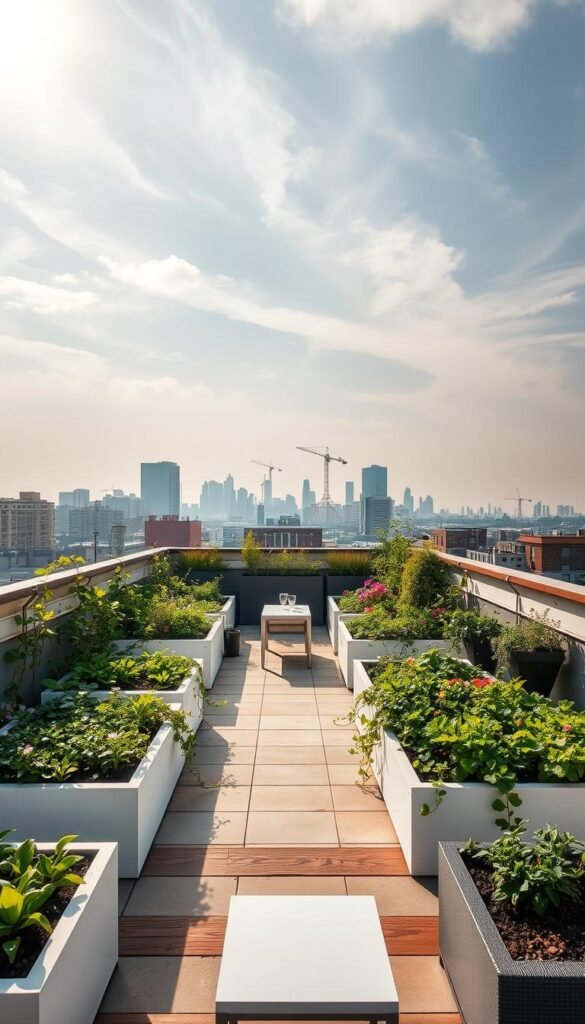Imagine stepping outside your door to a lush, productive area that grows fresh food while cooling your home. Many city dwellers overlook the potential of flat, underused surfaces above their heads. With smart design and modern techniques, these blank canvases can become vibrant ecosystems bursting with life.
You’ll discover how to maximize every inch of available area through modular planting systems and vertical growing solutions. Picture trellises heavy with tomatoes, compact herb spirals, and hanging baskets overflowing with strawberries. These methods triple your growing capacity without sacrificing style or functionality.
Beyond fresh produce, these elevated plots offer surprising environmental benefits. They act as natural insulators, reducing energy costs by keeping buildings cooler in summer. Their soil layers absorb rainwater, easing pressure on storm drains during heavy downpours. You’re not just growing greens – you’re nurturing a miniature ecosystem that supports bees, butterflies, and local wildlife.
This guide walks you through creating a thriving edible paradise in unexpected places. Learn to choose wind-resistant containers, position plants for optimal sunlight, and select crops that flourish in elevated conditions. Whether you’re a seasoned grower or a curious beginner, transforming overlooked areas into productive zones reconnects you with nature while enhancing your city’s green infrastructure.
Planning and Assessing Your Urban Rooftop Space

Your journey begins with a crucial safety check – ensuring your elevated growing zone can handle the project. Think of your building’s structure as the hidden hero supporting your green ambitions. Let’s break down what you need to verify before getting your hands dirty.
Crunching the Numbers for Safe Growth
Start by inviting a structural engineer to evaluate your roof’s limits. Residential spaces typically handle 30-40 pounds per square foot, but older constructions might support less. Consider every element: soil-filled containers, water reserves, and even your gardening tools add to the total weight.
Calculate smartly using this formula: (Container weight + wet soil + mature plants) × total units = your garden’s footprint. Lightweight potting mixes and modular planters become your best allies here.
Navigating the Paperwork Maze
Local regulations often surprise new growers. Contact your city’s building department to learn about required permits – especially if adding irrigation or permanent features. Many municipalities demand:
- Detailed layouts showing safety barriers and drainage plans
- Proof of maintained emergency exit routes
- Documentation of railings meeting 42-inch height minimums
Smart planning now prevents headaches later. Keep digital copies of all approvals and engineer reports – you’ll want these handy for future expansions or inspections.
Designing a Safe and Accessible Rooftop Garden
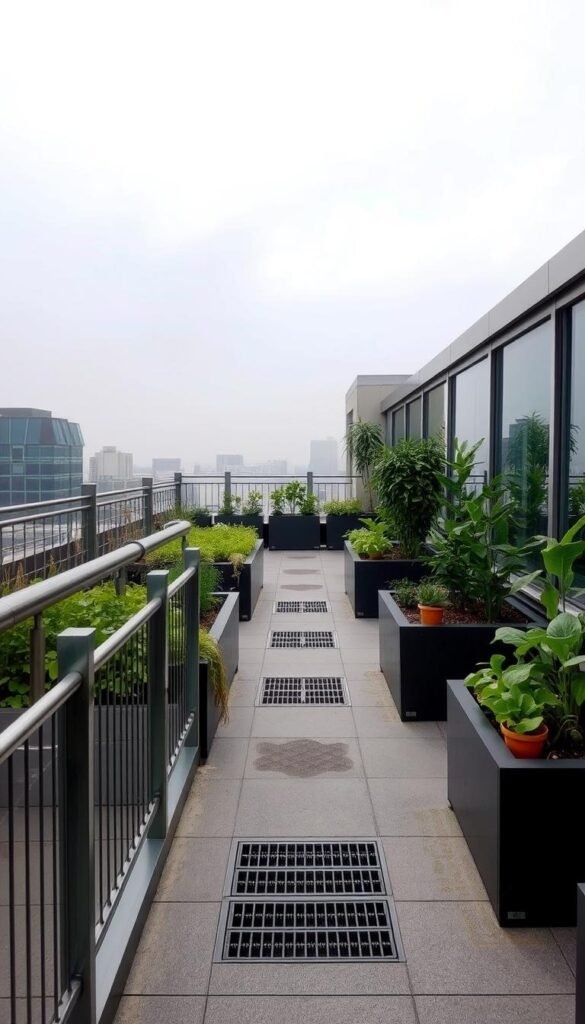
Creating a thriving green space above ground level requires smart safety planning. Let’s explore how to protect your structure while making the area easy to navigate and maintain.
Weatherproofing and Protective Measures
Start with waterproof membranes – these invisible shields stop leaks before they damage your building. Pair them with sloped drainage layers that guide excess water toward designated runoff points. This combo keeps roots healthy and structural supports dry.
High winds demand creative solutions. Anchor planters with galvanized straps and consider these windbreak options:
| Material | Visibility | Wind Reduction | Maintenance |
|---|---|---|---|
| Lattice panels | Partial | 40-50% | Yearly staining |
| Tempered glass | Full | 60-70% | Monthly cleaning |
| Polycarbonate sheets | Semi-transparent | 50-60% | Bi-annual inspection |
Pathways and Emergency Readiness
Keep walkways at least 36 inches wide using textured pavers that grip shoes in wet conditions. Mark emergency exits with glow-in-the-dark tape along railings. Local fire codes often require:
- Unlocked roof access doors
- Clear paths to stairwells
- Visible exit signage
Store permits and inspection reports digitally using cloud storage. This protects against loss and simplifies insurance updates. Smart planning today means fewer hassles tomorrow.
Mapping Your Garden Layout for Maximum Yield
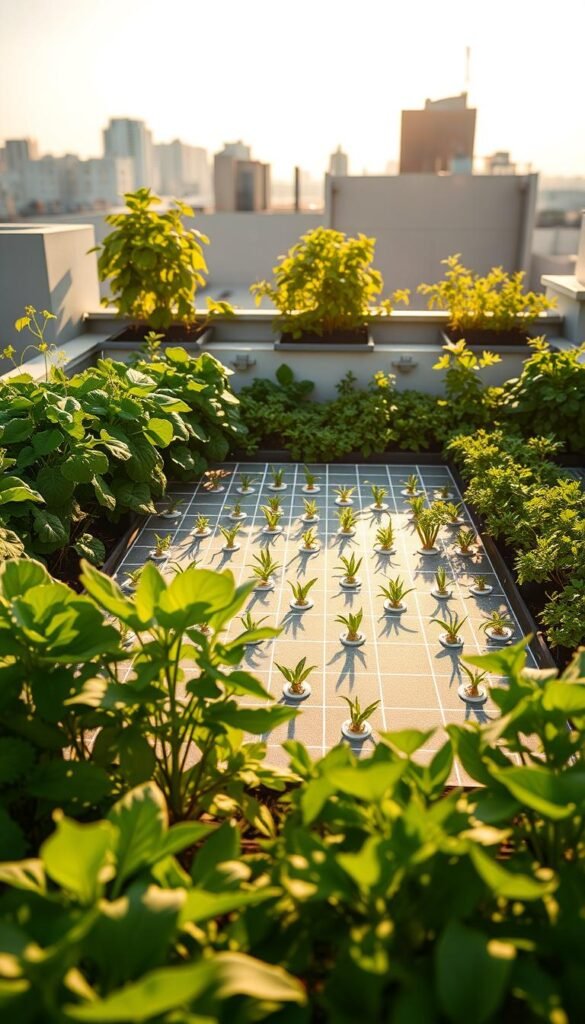
Charting your growing area transforms guesswork into strategy. Begin by measuring your available space with a laser measure or tape. Sketch fixed features like vents and utility boxes on grid paper – these become your garden’s permanent landmarks.
Identifying Sunlight and Shade Patterns
Track light patterns over three consecutive days using a free sun tracker app. Mark zones receiving:
- Full sun (6+ hours): Ideal for tomatoes and peppers
- Partial sun (4-6 hours): Perfect for leafy greens
- Shade (under 4 hours): Great for herbs like mint
Color-code your map with highlighters – yellow for sun zones, blue for shade. Place tall crops like corn on your sketch’s north edge to prevent shadowing shorter plants.
Establishing Zones for Similar Plant Needs
Group thirsty crops like cucumbers together near water sources. Create a companion planting table:
| High Water | Medium Water | Low Water |
|---|---|---|
| Tomatoes | Carrots | Rosemary |
| Zucchini | Beans | Lavender |
Leave 24-inch pathways between beds using crushed gravel or rubber mats. This planning phase ensures every square foot works efficiently while making maintenance simpler.
Smart Container Solutions and Gardening Systems
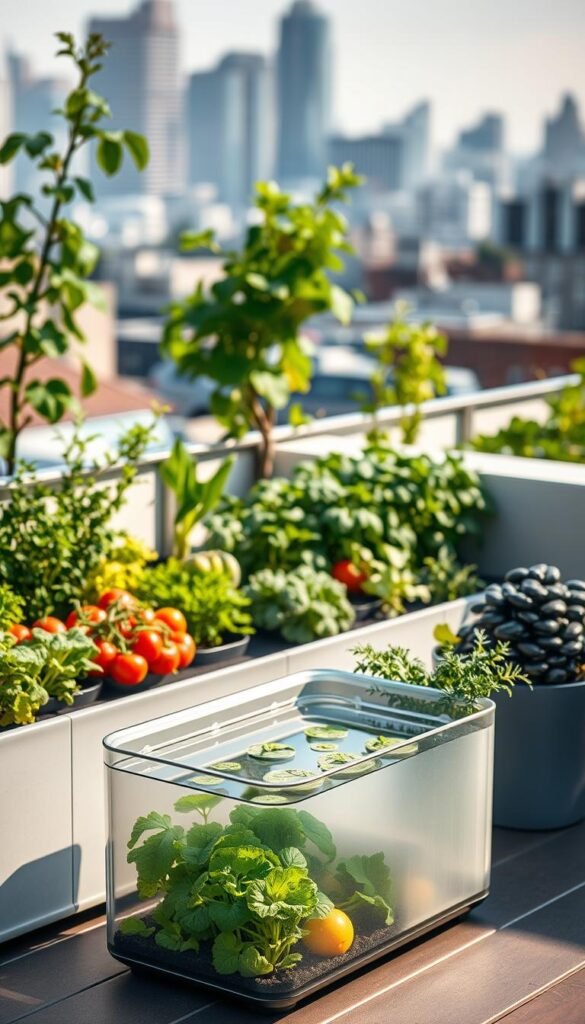
Your elevated growing space demands smart solutions that balance productivity with practicality. The right setup keeps your plants thriving while respecting structural limits and maintenance needs.
Choosing Self-Watering and Lightweight Containers
Self-watering systems eliminate guesswork with built-in reservoirs that feed roots through capillary action. Fill these clever containers weekly instead of daily – perfect for busy schedules. Pair them with fiberglass or recycled plastic planters that cut weight by 40% compared to ceramic alternatives.
Boost sustainability by adding rainwater collection barrels. These connect directly to your watering systems through simple drip lines. Mix water-storing crystals into potting soil to stretch moisture further during hot spells.
Optimizing Space with Raised Beds and Planters
Modular raised beds transform awkward corners into productive zones. Their deeper soil supports root vegetables like carrots while improving drainage. Consider these popular materials:
| Material | Weight | Durability | Cost |
|---|---|---|---|
| Fiberglass | 8 lbs/ft | 10+ years | $$$ |
| Plastic | 5 lbs/ft | 5-7 years | $$ |
| Fabric | 3 lbs/ft | 3-5 years | $ |
Stagger planters vertically using wall-mounted shelves. This creates microclimates – heat-loving herbs up top, shade-tolerant greens below. You’ll harvest more without overcrowding your space.
Weather-Smart Gardening Strategies for Urban Environments
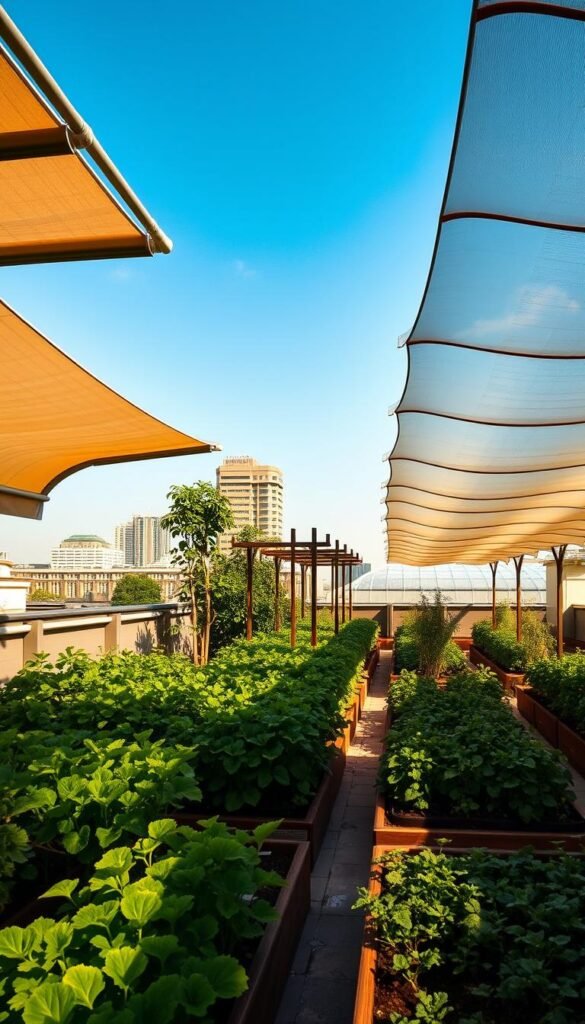
Gardening above street level brings unique challenges that demand smart solutions. Let’s explore practical ways to protect your green oasis from harsh weather while maintaining healthy growth.
Implementing Wind Protection Techniques
Strategic barriers make all the difference in windy areas. Install lattice panels or breathable mesh screens that filter gusts while letting air circulate. For natural protection, position tall crops like sunflowers or corn along your space’s edges – these living walls buffer delicate seedlings without blocking sunlight.
Portable solutions work best for changing seasons. Foldable fabric screens mounted on rolling frames let you adjust coverage as needed. Secure containers with rubberized bases or sandbag weights to prevent tipping during storms.
Managing Heat and Sunlight Exposure
Combat intense sunlight with adjustable shade systems. Retractable canvas covers or 30% UV-blocking netting reduce heat stress during peak hours. Position heat-loving varieties like peppers and eggplants where they’ll shield sensitive greens from afternoon rays.
Smart watering keeps roots happy in hot conditions. Use drip lines with timers to hydrate soil at dawn, minimizing evaporation. A 2-inch layer of straw mulch maintains moisture while keeping roots cooler than bare earth.
| Heat Solution | Installation | Effectiveness |
|---|---|---|
| Shade cloth | Overhead frame | Reduces temps by 10°F |
| Reflective mulch | Soil surface | Cuts root zone heat by 15% |
| Misting system | Perimeter lines | Cools air by 8°F |
Rooftop Vegetable Garden: Converting Unused Urban Spaces into Green Havens – Key Benefits and Essentials
Elevated growing areas offer more than just fresh snacks—they’re powerhouses for community and environmental health. These sky-high plots deliver measurable impacts, from cooling buildings to creating buzzing habitats for pollinators. You’ll find multiple rewards blooming alongside your tomatoes and basil.
Your leafy oasis becomes a natural air conditioner. Plants release moisture through their leaves, lowering surrounding temperatures by up to 9°F. This translates to real savings—buildings with green roofs use 25% less energy for cooling during summer months.
Food security gets a boost when you harvest veggies steps from your kitchen. No more wilted spinach from cross-country truck rides. Crisp greens picked minutes before eating retain more nutrients and flavor. You’re also insulating against supply chain hiccups that empty grocery shelves.
Stormwater management improves dramatically. Soil and plants absorb 70% of rainfall, reducing runoff that overwhelms city drains. This natural filtration system keeps waterways cleaner while preventing urban flooding during heavy downpours.
Beyond practical perks, these spaces strengthen communities. Neighbors bond over shared harvests, while rooftops become peaceful retreats from concrete landscapes. Studies show spending just 20 minutes daily among plants lowers stress hormones by 15%.
| Benefit | Impact | Savings |
|---|---|---|
| Energy Efficiency | 25% cooling reduction | $200+/year |
| Stormwater Capture | 70% absorption rate | Municipal cost cuts |
| Food Production | 100+ lbs annually | $500 grocery savings |
Selecting Ideal Plants and Herbs for Rooftop Success
Not all plants thrive above ground—discover which ones excel in your unique setup. The right choices turn challenging conditions into productive advantages, blending beauty with practicality.
Edible Vegetables, Fruits, and Herbs
Cherry tomatoes lead the pack with sturdy roots that anchor them against winds. Determinate varieties stay compact, perfect for containers. Peppers bask in the heat, delivering sweet or spicy fruits all season.
Mediterranean herbs like rosemary and thyme flourish with minimal fuss. Their drought tolerance matches rooftop conditions perfectly. For fresh flavors, try basil—it thrives in sunny spots with well-draining soil.
Climate-Hardy Ornamentals and Companion Planting
Lavender adds purple hues while repelling pests naturally. Marigolds protect nearby crops and brighten your space. These ornamentals work double duty, supporting your edible plants.
Pair mint with cabbage to deter pests, or grow nasturtiums near tomatoes. Smart combinations boost yields without chemicals. For more urban gardening strategies, explore companion planting guides.

